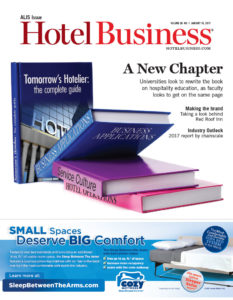Hotel industry experts predict 2017 will be a year of minor declines in occupancy and modest growth in rate and RevPAR, moving further into a general downward phase of the current lodging cycle. The good news is, most segment occupancies—despite decreasing—are expected to still remain near record-high levels.
That’s squarely keeping the focus of hoteliers on raising rates and RevPAR, albeit at diminishing growth rates. Some segments are projected to push further than others this year, but, in general, a two- to three-point increase in ADR and RevPAR is the expectation, particularly in sectors and markets absorbing significant new supply.
“I think it’s an interesting time, because the fundamentals are still strong, but there’s no doubt that we’re seeing so much supply growth that we have to expect that we’ll have some markets with RevPAR declines, and other markets where RevPAR’s rate of growth will slow a bunch,” said Bob Habeeb, president and CEO of First Hospitality Group. “That’s what we’ve been seeing, especially in markets like Chicago, where we have a concentration and there’s been a lot of new product.”
Overall, the national outlook is fairly consistent: CBRE Hotels’ Americas Research is expecting a 2017 occupancy dip of -0.4% to 65.0% overall, an ADR gain of 3.3% to $128.32 and RevPAR growth of 2.9%, to $83.43. STR offered a similar forecast for the industry, with a year-end 2017 occupancy decline of -0.5%, ADR growth of 2.8% and a RevPAR increase of 2.3%.
That said, researchers also stressed the importance of a market-by-market and segment-specific approach to performance analysis at the moment. There is so much fluctuation, whether it’s due to localized new supply or other microeconomic factors currently impacting a singular market’s performance, it seems 2017 will be difficult to paint with an overly broad brush.
“The national picture continues to look positive; however, we really think it’s much more relevant today to be focused at the market level, because that’s where the action is, and that’s where we’re seeing a lot of variation across cities,” said R. Mark Woodworth, senior managing director, head of lodging research, CBRE Hotels’ Americas Research. “Some continue to do extraordinarily well. I think we’re forecasting RevPAR growth in the high single digits, and we’ve got a number of markets where RevPAR is going to be contracting year over year.”
The main market-specific factor here in 2017 is new supply, which is expected to grow by 2.0% overall this year by STR and 1.8% by CBRE Hotels’ Americas Research, against predicted demand growth of 1.5% by each of the firms. However supply growth varies widely between locations and market segments. Right now, the majority of new rooms under construction remain within the upper-midscale and upscale segments, so competition is expected to tighten this year among those chainscales’ respective brands. As for locations, cities like New York, Houston and Chicago are some of the markets tasked with absorbing sizeable jumps in room count.
“There’s no question that some markets—and importantly some of the larger domestic markets—have in fact been seeing significant supply growth,” said Woodworth. “The story certainly starts with New York and places like Houston. One contributing factor as to why at the national level prices haven’t been moving as quickly as we thought is some of the bigger markets. First and foremost, it’s because of the scale of the new supply that’s opened up and will be opening up in the near future.”
A second contributing factor at the market level that’s also driving the overall domestic outlook is the multitude of issues being faced within the local economies of some major markets. For example, energy markets like Houston are undergoing economic contraction and, still worse, it’s happening in the face of bountiful new room supply. In South Florida, meanwhile, it’s been a double-whammy of the strong dollar hurting inbound international visitation, as well as bookings declines stemming from fears over the Zika virus.
“Zika was the one factor that a lot of the other markets did not have to overcome,” said Shawn Gracey, EVP of hospitality for Key International. “If you’re a meeting planner and you’re bringing meetings to Miami, and any one of your attendees is planning on having a family or is pregnant, they’re not going to attend one of your events, just based on the fear of Zika. We’ve seen a lot of cancellations in group.”
Offsetting some of those ongoing concerns has been a generalized sense of optimism for the coming year stemming from a potential economic boost some believe will occur under the incoming Trump administration. A spike in construction activity may occur if the nation sees renewed investment in infrastructure under Donald Trump, which could boost hotel demand, while others hope Trump’s policies soften the impact of rising labor costs. If these hunches are correct, sources said that current forecasts may prove somewhat conservative when looking back this time next year.
“The thing that seems to be a little encouraging is the movement in the stock market in terms of what happened with the election and the potential that has to spur the economy,” said Bobby Bowers, SVP of operations for STR. “Even without that, a lot of the economists seem to think there’s going to be a little better performance in the economy in general. These past two months of 2016 were good months, so we may roll into next year with a little momentum. We may see a little bit stronger growth than we think.”

